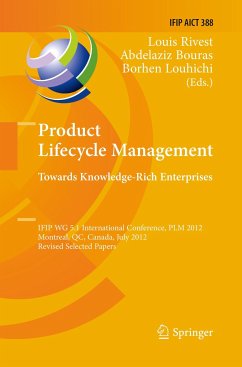Product Lifecycle Management: Towards Knowledge-Rich Enterprises
IFIP WG 5.1 International Conference, PLM 2012, Montreal, QC, Canada, July 9-11, 2012, Revised Selected Papers
Herausgegeben:Rivest, Louis; Bouras, Abdelaziz; Louhichi, Borhen
Product Lifecycle Management: Towards Knowledge-Rich Enterprises
IFIP WG 5.1 International Conference, PLM 2012, Montreal, QC, Canada, July 9-11, 2012, Revised Selected Papers
Herausgegeben:Rivest, Louis; Bouras, Abdelaziz; Louhichi, Borhen
- Broschiertes Buch
- Merkliste
- Auf die Merkliste
- Bewerten Bewerten
- Teilen
- Produkt teilen
- Produkterinnerung
- Produkterinnerung
This book constitutes the refereed post-proceedings of the 9th IFIP WG 5.1 International Conference on Product Lifecycle Management, PLM 2012, held in Montreal, Canada, in July 2012. The 58 full papers presented were carefully reviewed and selected from numerous submissions. They cover a large range of topics such as collaboration in PLM, tools and methodologies for PLM, modeling for PLM, and PLM implementation issues.
Andere Kunden interessierten sich auch für
![Product Lifecycle Management for Society Product Lifecycle Management for Society]() Product Lifecycle Management for Society82,99 €
Product Lifecycle Management for Society82,99 €![Product Lifecycle Management for Society Product Lifecycle Management for Society]() Product Lifecycle Management for Society82,99 €
Product Lifecycle Management for Society82,99 €![Product Lifecycle Management for Digital Transformation of Industries Product Lifecycle Management for Digital Transformation of Industries]() Product Lifecycle Management for Digital Transformation of Industries82,99 €
Product Lifecycle Management for Digital Transformation of Industries82,99 €![Product Lifecycle Management for a Global Market Product Lifecycle Management for a Global Market]() Product Lifecycle Management for a Global Market81,99 €
Product Lifecycle Management for a Global Market81,99 €![Product Lifecycle Management for a Global Market Product Lifecycle Management for a Global Market]() Product Lifecycle Management for a Global Market81,99 €
Product Lifecycle Management for a Global Market81,99 €![A Unified Approach to Quantitative Software Lifecycle Modeling A Unified Approach to Quantitative Software Lifecycle Modeling]() D. Vijay RaoA Unified Approach to Quantitative Software Lifecycle Modeling51,99 €
D. Vijay RaoA Unified Approach to Quantitative Software Lifecycle Modeling51,99 €![Managing Requirements Knowledge Managing Requirements Knowledge]() Managing Requirements Knowledge81,99 €
Managing Requirements Knowledge81,99 €-
-
-
This book constitutes the refereed post-proceedings of the 9th IFIP WG 5.1 International Conference on Product Lifecycle Management, PLM 2012, held in Montreal, Canada, in July 2012. The 58 full papers presented were carefully reviewed and selected from numerous submissions. They cover a large range of topics such as collaboration in PLM, tools and methodologies for PLM, modeling for PLM, and PLM implementation issues.
Produktdetails
- Produktdetails
- IFIP Advances in Information and Communication Technology 388
- Verlag: Springer / Springer Berlin Heidelberg / Springer, Berlin
- Artikelnr. des Verlages: 978-3-642-44244-5
- 2012
- Seitenzahl: 676
- Erscheinungstermin: 30. Januar 2015
- Englisch
- Abmessung: 235mm x 155mm x 37mm
- Gewicht: 1021g
- ISBN-13: 9783642442445
- ISBN-10: 3642442447
- Artikelnr.: 42959482
- Herstellerkennzeichnung Die Herstellerinformationen sind derzeit nicht verfügbar.
- IFIP Advances in Information and Communication Technology 388
- Verlag: Springer / Springer Berlin Heidelberg / Springer, Berlin
- Artikelnr. des Verlages: 978-3-642-44244-5
- 2012
- Seitenzahl: 676
- Erscheinungstermin: 30. Januar 2015
- Englisch
- Abmessung: 235mm x 155mm x 37mm
- Gewicht: 1021g
- ISBN-13: 9783642442445
- ISBN-10: 3642442447
- Artikelnr.: 42959482
- Herstellerkennzeichnung Die Herstellerinformationen sind derzeit nicht verfügbar.
In Collaborative Product Development.- Several Aspects of Information Flows in PLM.- Managing Knowledge Needs during New Product Lifecycle Design on Quick-term Project Development QPD: Case Study of 24 Hours of Innovation - ETS Montreal.- Functional Architecture and Specifications for Tolerancing Data and Knowledge Management.- The Role of Internal and External Sources of Knowledge in the Product Lifecycle in Biotechnology Sector.- Towards the Definition of Domain Concepts and Knowledge through the Application of the User Story Mapping Method.- Mereotopological Description of Product-Process Information and Knowledge for PLM.- The Need for Improved Integration between PLM and KM: A PLM Services Provider Point of View.- ECO-Boat MOL Capturing Data from Real Use of the Product.- Shift from PLM to SLM: A Method to Support Business Requirements Elicitation for Service Innovation.- Life-Cycle Oriented Requirement Formalization and Traceability.- PLM (Product Lifecycle Management) Model for Supply Chain Optimization.- PLM Interoperability with Information Systems.- Manufacturing Process Planning in Set-Based Concurrent Engineering Paradigm.- PLM-Based Service Data Management in Steam Turbine Business.- Verification of Item Usage Rules in Product Configuration.- DMU Maturity Management as an Extension of the Core Product.- Design and Implementation of a PLM System for Sustainable Manufacturing.- Visual and Interactive Tool for Product Development Process Enhancement: Towards Intuitive Support of Co-located Project Review.- Virtually Indistinguishable: Systems Engineering and PLM.- Product Data Reuse in Product Development: A Practitioner's Perspective.- Operational Framework Based on Modeling Languages to Support Product Repository Implementation.- Adapting Product and Development Process for Risk Reduction in New Product Development.- Product Life Cycle Oriented Representation of Uncertainty.- Learning Methodologies to Diffuse Lean Product Development toIndustries.- Set-Based Prototyping with Digital Mock-Up Technologies.- Improved Span Time Performance in NPD Using Better Coordination.- The Role of Product Lifecycle Management Systems in Organizational Innovation.- Creative Tools and Processes to Remain Competitive in the Twenty-First Century.- Towards PLM for Mechatronics System Design Using Concurrent Software Versioning Principles.- Lifecycle Oriented Planning of Mechatronic Products and Corresponding Services.- Design System Assessment Tool.- Software Management in Product Structure.- PLMXQuery: Towards a Standard PLM Querying.- Study on Collaborative Product Development and Digital Engineering Tools.- Can a Product Have a Facebook? A New Perspective on Product Avatars in Product Lifecycle Management.- Management of Associations within Digital Mock-Ups for Improved Collaboration.- A Framework for Evaluating Collaborative Product Representations in Product Lifecycle Workflows.- Future Product Lifecycle Management (PLM) - A Consideration of Informal Communication as a Key Enabler for Future Product Development.- Integration of Explicit Geometric Constraints in the Comparison of 3D CAD Models for Part Design Reuse.- From Functional Analysis to CAD Modelling Based on Knowledge Transformation Driven by the Design Process.- A BREP Model and Mesh Errors Detecting Tool: TopoVisu.- A Modeling Language for 3D Process Plant Layout Representation, Exchange and Visualization.- PLM as Support for Global Design Reuse - Long Term Benefits and Immediate Drawbacks.- PLM Impact Analysis Model - PIA.- A Method to Identify Risks Associated with a PLM Solution.- PLM Reference Model: A Preliminary Proposal for Reference Model Evolution.- Decision Support Framework for PLM Harmonization Projects within Industrial.- Collaborative Design Tools: A Comparison between Free Software and PLM Solutions in Engineering Education.- A Holistic Approach for the Architecture and Design of an Ontology-Based Data Integration Capability inProduct Master Data Management.- Dynamic Customization and Validation of Product Data Models Using Semantic Web Tools.- Toward an Automatic Reduction of Non-added Values Tasks in the Project-Product-Process Domain.- SWRL as a Rule Language for Ontology-Based Models in Power Plant Design.- Visual Product Architecture Modelling for Structuring Data in a PLM System.- Towards Model-Based System Engineering for Simulation-Based Design in Product Data Management Systems.- Defining the Customer Dimension of PLM Maturity.- Maturity Model for Improving Virtual Engineering in Small and Medium-Sized Enterprises.- Approach on Lifecycles on Research Environment and Analysis Based on Systems Engineering (SE).
In Collaborative Product Development.- Several Aspects of Information Flows in PLM.- Managing Knowledge Needs during New Product Lifecycle Design on Quick-term Project Development QPD: Case Study of 24 Hours of Innovation - ETS Montreal.- Functional Architecture and Specifications for Tolerancing Data and Knowledge Management.- The Role of Internal and External Sources of Knowledge in the Product Lifecycle in Biotechnology Sector.- Towards the Definition of Domain Concepts and Knowledge through the Application of the User Story Mapping Method.- Mereotopological Description of Product-Process Information and Knowledge for PLM.- The Need for Improved Integration between PLM and KM: A PLM Services Provider Point of View.- ECO-Boat MOL Capturing Data from Real Use of the Product.- Shift from PLM to SLM: A Method to Support Business Requirements Elicitation for Service Innovation.- Life-Cycle Oriented Requirement Formalization and Traceability.- PLM (Product Lifecycle Management) Model for Supply Chain Optimization.- PLM Interoperability with Information Systems.- Manufacturing Process Planning in Set-Based Concurrent Engineering Paradigm.- PLM-Based Service Data Management in Steam Turbine Business.- Verification of Item Usage Rules in Product Configuration.- DMU Maturity Management as an Extension of the Core Product.- Design and Implementation of a PLM System for Sustainable Manufacturing.- Visual and Interactive Tool for Product Development Process Enhancement: Towards Intuitive Support of Co-located Project Review.- Virtually Indistinguishable: Systems Engineering and PLM.- Product Data Reuse in Product Development: A Practitioner's Perspective.- Operational Framework Based on Modeling Languages to Support Product Repository Implementation.- Adapting Product and Development Process for Risk Reduction in New Product Development.- Product Life Cycle Oriented Representation of Uncertainty.- Learning Methodologies to Diffuse Lean Product Development toIndustries.- Set-Based Prototyping with Digital Mock-Up Technologies.- Improved Span Time Performance in NPD Using Better Coordination.- The Role of Product Lifecycle Management Systems in Organizational Innovation.- Creative Tools and Processes to Remain Competitive in the Twenty-First Century.- Towards PLM for Mechatronics System Design Using Concurrent Software Versioning Principles.- Lifecycle Oriented Planning of Mechatronic Products and Corresponding Services.- Design System Assessment Tool.- Software Management in Product Structure.- PLMXQuery: Towards a Standard PLM Querying.- Study on Collaborative Product Development and Digital Engineering Tools.- Can a Product Have a Facebook? A New Perspective on Product Avatars in Product Lifecycle Management.- Management of Associations within Digital Mock-Ups for Improved Collaboration.- A Framework for Evaluating Collaborative Product Representations in Product Lifecycle Workflows.- Future Product Lifecycle Management (PLM) - A Consideration of Informal Communication as a Key Enabler for Future Product Development.- Integration of Explicit Geometric Constraints in the Comparison of 3D CAD Models for Part Design Reuse.- From Functional Analysis to CAD Modelling Based on Knowledge Transformation Driven by the Design Process.- A BREP Model and Mesh Errors Detecting Tool: TopoVisu.- A Modeling Language for 3D Process Plant Layout Representation, Exchange and Visualization.- PLM as Support for Global Design Reuse - Long Term Benefits and Immediate Drawbacks.- PLM Impact Analysis Model - PIA.- A Method to Identify Risks Associated with a PLM Solution.- PLM Reference Model: A Preliminary Proposal for Reference Model Evolution.- Decision Support Framework for PLM Harmonization Projects within Industrial.- Collaborative Design Tools: A Comparison between Free Software and PLM Solutions in Engineering Education.- A Holistic Approach for the Architecture and Design of an Ontology-Based Data Integration Capability inProduct Master Data Management.- Dynamic Customization and Validation of Product Data Models Using Semantic Web Tools.- Toward an Automatic Reduction of Non-added Values Tasks in the Project-Product-Process Domain.- SWRL as a Rule Language for Ontology-Based Models in Power Plant Design.- Visual Product Architecture Modelling for Structuring Data in a PLM System.- Towards Model-Based System Engineering for Simulation-Based Design in Product Data Management Systems.- Defining the Customer Dimension of PLM Maturity.- Maturity Model for Improving Virtual Engineering in Small and Medium-Sized Enterprises.- Approach on Lifecycles on Research Environment and Analysis Based on Systems Engineering (SE).








